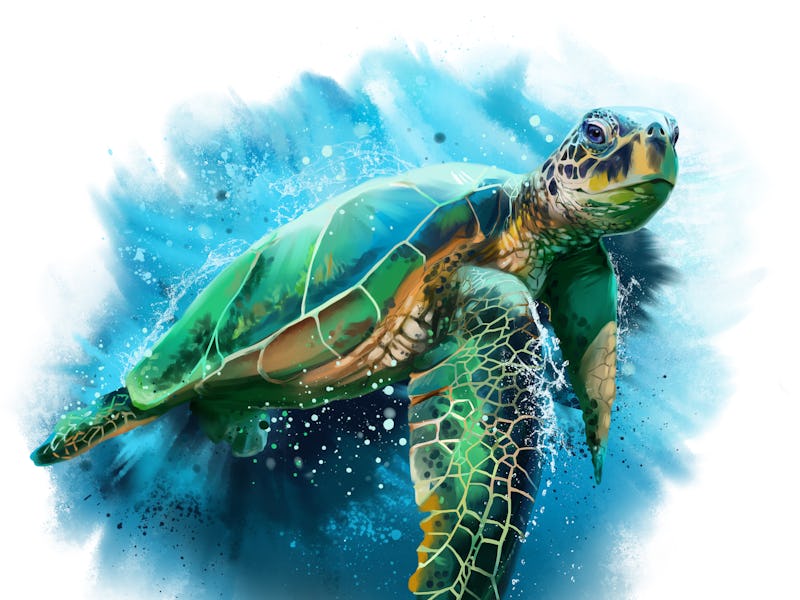Study serves an unprecedented look at how sea turtles make 500-mile journeys
With a crude internal map, turtles find remote islands — eventually.

Sea turtles travel thousands of miles throughout their lives — circling the ocean's tropical waters, often landing on tiny remote islands.
New research reveals how, exactly, these shelled travelers make their way around the globe.
Scientists tracked 33 green sea turtles, Chelonia mydas, as they moved through a months-long journey that began at the beaches where the turtles nest, in the Chagos Archipelago in the Indian Ocean.
They discovered that turtles circled around before arriving at remote islands, rather than traveling directly, suggesting that the turtles have only a rudimentary internal navigation system.
In the study, published Thursday in the journal Current Biology, researchers report that the green sea turtles may be following Earth's geomagnetic field to travel the ocean.
Researchers attached satellite tags to female sea turtles while they were nesting in Chagos, allowing them to follow the turtles' progress when they left and eventually made their return to the nesting beaches. They found that the turtles had a roundabout way of arriving at some of the more remote, harder-to-find islands.
Some of them circled around the target, or overshot it by hundreds of kilometers, then spent weeks searching for their destination, the researchers say.
"The study provides some of the best evidence to date that migrating sea turtles have an ability to redirect in the open ocean, but only at a crude level rather than at fine scales," study co-author Alex Rattray, a researcher at Deakin University, tells Inverse.
Previous data has followed turtles to mainland coasts, "where the navigational problems are less complex," Rattray says. Research into how turtles reach smaller islands is rarer and helps to show just how accurately green turtles follow their course.
"It turns out that the turtle’s map sense is quite coarse, but it does the job," Rattray says.
Turtles' map skills may be rudimentary, but they travel for impressive distances: Six of the turtles traveled from Chagos to various places along Africa's east coast and back, clocking more than 500 miles.
Video shows the how 35 green turtles migrated from nesting beaches in the Indian Ocean.
Tracking turtles — Sea turtles get their navigation cues from Earth's magnetic field, like many fish, reptiles, birds, and mammals that complete long-term journeys.
Rattray's team has been satellite tracking sea turtles as part of a conservation effort.
Having a better understanding of how turtles migrate and where they forage can provide better information to governments and agencies to help protect the species, Rattray says.
"To tag a female turtle while she is nesting we wait for her to move up the beach, dig a nest, and lay a clutch of eggs," Rattray explains. "As she moves back to the water we attach a small satellite tag with an aerial at the front of the carapace and shape it with resin to create as little drag as possible."
Female sea turtle with tracking device.
For up to 18 months, the researchers can follow the turtle as she travels the world. Then, the turtle will shed the outer layer of her shell and the tag will fall off.
The satellite data can help conservationists identify key areas for sea turtle protection, the researchers say.
"As well as shedding light on turtle navigation, we show that individuals from one nesting area travel broadly across an ocean basin once the nesting season is finished," Rattray says. "So conservation measures need to apply across these spatial scales and across many countries."
Abstract: In 1873, Charles Darwin marveled at the ability of sea turtles to find isolated island breeding sites [1], but the details of how sea turtles and other taxa navigate during these migrations remains an open question [2]. Exploring this question using free-living individuals is difficult because, despite thousands of sea turtles being satellite tracked across hundreds of studies [3], most are tracked to mainland coasts where the navigational challenges are easiest. We overcame this problem by recording unique tracks of green turtles (Chelonia mydas) migrating long distances in the Indian Ocean to small oceanic islands. Our work provides some of the best evidence to date, from naturally migrating sea turtles, for an ability to reorient in the open ocean, but only at a crude level. Using individual-based models that incorporated ocean currents, we compared actual migration tracks against candidate navigational models to show that turtles do not reorient at fine scales (e.g., daily), but rather can travel several 100 km off the direct routes to their goal before reorienting, often in the open ocean. Frequently, turtles did not home to small islands with pinpoint accuracy, but rather overshot and/or searched for the target in the final stages of migration. These results from naturally migrating individuals support the suggestion from previous laboratory work [4–6] that turtles use a true navigation system in the open ocean, but their map sense is coarse scale.